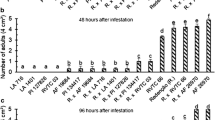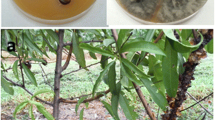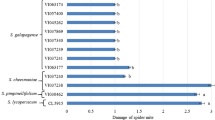Abstract
We have previously found an accession of Lycopersicon pimpinellifolium (Jusl.) Mill. (`TO-937') that appeared to resist attack by the two-spotted spider mite (Tetranychus urticae Koch). L. pimpinellifolium is a very close relative of the cultivated tomato (Lycopersicon esculentum Mill.) and thereby a potential source of desirable traits that could be introgressed to the crop species. The objective of this study was to investigate the genetics of the resistance present in `TO-937'. Resistance to infestation by the spider mite was quantified in 24-plant plots of L. pimpinellifolium accessions `TO-937' and `PE-10', L. pennellii accession `PE-45', L. esculentum cultivars `Moneymaker', `Roma' and `Kalohi' (reported to be partially resistant: Stoner & Stringfellow, 1967), and the interspecific F1 cross, L. esculentum `Moneymaker' × L. pimpinellifolium `TO-937'. Only `TO-937', the F1, and`PE-45' were found to be resistant. Resistance of `TO-937' was complete when evaluated in two small greenhouses completely planted with `TO-937' so as to simulate the genotypic homogeneity usual in commercial crops. Generations (P1, P2, F1, F2, BC1P1, and BC1P2) of a P1 (susceptible) × P2 (resistant) cross (`Moneymaker' × `TO-937') were studied for resistance in a single-plant per plot design. Resistance of `TO-937' was inherited with complete dominance and appeared to be controlled by either two or four genes according to whether segregation in the F2 or the BC1P1, respectively, were considered. However, calculation of the number of genes involved in the resistance was complicated by negative interplot interference due to the high frequency of resistant genotypes within most of the generations.
Similar content being viewed by others
References
Berlinger, M.J., 1986. Pests. In: J.G. Atherton & J. Rudich (Eds), The Tomato Crop: A Scientific Basis for Improvement, pp. 391–441. Chapman & Hall, New York.
Gentile, A.G., R.E. Webb & A.K. Stoner, 1969. Lycopersicon and Solanum spp. resistant to the carmine and the two-spotted spider mite. J Econ Entomol 68: 834–836.
Gonçalves, M.I.F., W.R. Maluf, L.A.A. Gomes & L.V. Barbosa, 1998. Variation of 2–Tridecanone level in tomato plant leaflets and resistance to two mite species (Tetranychus sp.). Euphytica 104: 33–38.
Guo, Z., P.A. Weston & J.C. Snyder, 1993. Repellency to twospotted spider mite, Tetranychus urticae Koch, as related to leaf surface chemistry of Lycopersicon hirsutum accessions. J Chem Ecol 19: 2965–2979.
James W.C., C.S. Shih, L.C. Callbeck & W.A. Hodgson, 1973. Interplot interference in field experiments with late blight of potato (Phytophthora infestans). Phytopathology 63: 1269–1275.
Levin, D.A., 1973. The role of trichomes in plant defense. Quart Rev Biol 48: 3–15.
Parlevliet, J.E. & A. Van Ommeren, 1984. Interplot interference and the assessment of barley cultivars for partial resistance to leaf rust, Puccinia hordei. Euphytica 33: 685–697.
Rick, C.M., 1979. Biosystematic studies in Lycopersicon and closely related species of Solanum. In: J.G. Hawkes, R.N. Lester & A.D. Skelding (Eds), The Biology and Taxonomy of the Solanaceae, pp. 667–678. Academic Press, New York.
Stevens, M.J. & C.M. Rick, 1986. Genetics and breeding. In: J.G. Atherton & J. Rudich (Eds), The Tomato Crop: A Scientific Basis for Improvement, pp. 35–109. Chapman & Hall, New York.
Van der Plank, J.E., 1963. Plant diseases: epidemics and control. Academic Press, New York.
Stoner, A.K. & T. Stringfellow, 1967. Resistance of tomato varieties to spider mites. Proc Amer Soc Hort Sci 90: 324–329.
Walters, D.S. & J.C. Steffens, 1990. Branched chain amino acid metabolism in the biosynthesis of Lycopersicon pennellii glucose esters. Plant Physiol 93: 1544–1551.
Weston, P.A., A.D. Johnson, H.T. Burton & J.C. Snyder, 1989. Trichome secretion composition, trichome densities, and spider mite resistance of ten accessions of Lycopersicon hirsutum. J Amer Soc Horticult Sci 114: 492–498.
Weston, P.A. & J.C. Snyder, 1990. Thumbtack bioassay: a quick method for measuring plant resistance to two-spotted spider mites (Acari: Tetranychidae). J Econ Entomol 83: 501–504.
Author information
Authors and Affiliations
Rights and permissions
About this article
Cite this article
Fernández-Muñoz, R., Domínguez, E. & Cuartero, J. A novel source of resistance to the two-spotted spider mite in Lycopersicon pimpinellifolium (Jusl.) Mill.: its genetics as affected by interplot interference. Euphytica 111, 169–173 (2000). https://doi.org/10.1023/A:1003893432676
Issue Date:
DOI: https://doi.org/10.1023/A:1003893432676




